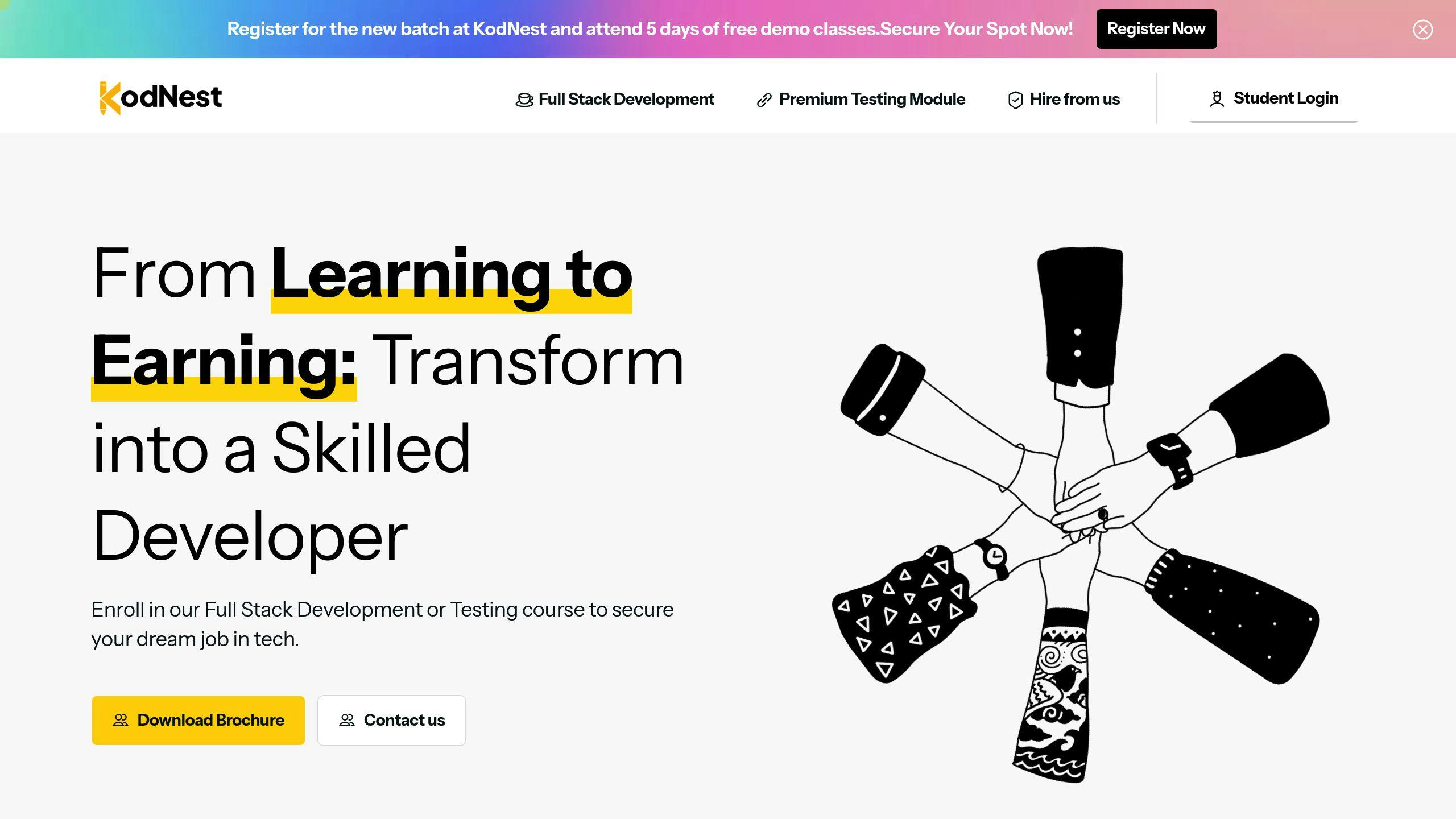Python full stack development combines front-end and back-end skills to build scalable web applications. This course covers advanced Python programming, frameworks like Django and Flask, database management, API development, and deployment strategies. Here’s a quick overview of the key topics:
- Advanced Python: Data structures, error handling, concurrency, and multithreading.
- Frameworks: Django for large-scale projects, Flask for lightweight applications.
- Database Management: SQL and NoSQL databases with ORM integration.
- API Development: RESTful APIs, authentication, and front-end integration.
- Deployment: Docker, cloud platforms, and security practices.
- Professional Skills: Agile methodologies, version control, and CI/CD pipelines.
This course is designed for beginners, career switchers, and experienced developers aiming to master Python full stack development.
Python Full Stack Course: Advanced Concepts with Django, Flask, and React

Advanced Python Concepts
Advanced Python programming plays a key role in full stack development, allowing developers to create efficient and scalable web applications. Here are some important concepts that help developers build professional-grade applications.
Advanced Python Programming
Python’s advanced features are crucial for handling complex tasks. Understanding data structures like lists, dictionaries, sets, and tuples is essential for managing data effectively in web applications. Additionally, reusable components like classes and objects simplify large-scale projects. For instance, frameworks like Django rely on these concepts for defining models and database schemas.
Error Handling and Debugging
Good error handling is vital for building reliable applications. Python’s try-except-finally structure, combined with debugging tools like pdb, helps developers quickly identify and resolve issues. Here’s a simple example:
try:
process_data()
except DatabaseError as e:
logging.error(f"Database operation failed: {e}")
finally:
cleanup_resources()
This approach ensures that errors are managed properly while keeping the application stable.
Concurrency and Multithreading
Efficient multitasking is a must for web applications. Python offers several tools for concurrent programming:
- Threading: Ideal for I/O-bound tasks.
- Multiprocessing: Best for CPU-intensive operations.
- Async/await: Useful for handling network-related tasks.
For example, using a thread pool can help manage multiple tasks like processing HTTP requests:
from concurrent.futures import ThreadPoolExecutor
with ThreadPoolExecutor(max_workers=10) as executor:
future_to_url = {executor.submit(fetch_url, url): url for url in urls}
These techniques make it easier to handle high-traffic scenarios or complex workflows effectively.
Frameworks and Back-End Development
Back-end development is the backbone of web applications, and Python provides versatile frameworks to handle projects of various sizes. Here’s a closer look at the tools that make back-end development efficient and scalable.
Django for Large-Scale Applications
Django is a go-to framework for building complex web applications. Known for its "batteries-included" philosophy, it provides developers with a wide range of built-in tools, reducing the need for external libraries. This makes Django a reliable choice for platforms that experience high traffic and require advanced features [1].
Key highlights include its ORM (Object-Relational Mapping), built-in admin interface, and secure authentication system. These features not only simplify the development process but also ensure that applications remain scalable and secure. Django is particularly strong when it comes to managing complex data relationships and handling large-scale projects.
Flask for Small-Scale Applications
Flask takes a simpler, more flexible approach, which makes it perfect for smaller projects or microservices. Developers often choose Flask for lightweight applications or when building microservices quickly. Its modular design allows for the inclusion of only the components you need, keeping applications efficient and streamlined.
Both Django and Flask can be paired with front-end frameworks to create dynamic, user-friendly web applications, offering flexibility for full-stack development.
Database Management
Managing databases effectively is a critical aspect of back-end development. Depending on the project, developers can choose between SQL and NoSQL databases, each with its own strengths:
- SQL Databases: Best for structured data, complex relationships, and ensuring data accuracy.
- NoSQL Databases: Better suited for unstructured data, scalability, and handling high data volumes.
Django’s ORM simplifies database interactions by converting Python objects into database queries, minimizing the need for writing SQL manually. With a solid back-end setup, the next challenge is integrating it seamlessly with front-end tools and APIs.
Front-End Integration and API Development
Modern full-stack development connects back-end systems with front-end technologies to build responsive and dynamic web applications. This setup ensures smooth user interactions while maintaining strong server-side functionality.
Front-End and API Integration
Python-based back-end systems work effortlessly with modern JavaScript frameworks like React, Angular, and Vue.js. These frameworks are widely used to create dynamic front-end interfaces that communicate with Python back-ends via well-structured APIs.
APIs act as the communication link between the client-side and server-side components. To design effective APIs, focus on:
- Endpoint Structure: Use clear, intuitive URLs that represent resource relationships.
- Data Serialization: Convert Python objects into JSON format for smooth data exchange.
- HTTP Methods: Handle requests appropriately (e.g., GET for retrieving data, POST for creating, PUT for updating, DELETE for removing).
"APIs handle requests and responses, allowing users to fetch, insert, delete, or update data." – GeeksforGeeks, Python API Tutorial [2]
Authentication and Authorization
Securing applications involves two main components:
- JWT (JSON Web Tokens): Provides stateless authentication, making it easier to securely transmit user data across distributed systems.
- Role-Based Access Control (RBAC): Django’s built-in permission system lets developers define user roles, set up hierarchies, and control access at both the model and view levels.
These tools help create secure and scalable applications that align with current development practices. Once front-end integration and APIs are in place, the focus shifts to deploying these applications effectively using modern deployment tools.
sbb-itb-f454395
Application Deployment and Advanced Topics
Once the front-end and back-end are integrated, the next step is deploying the application securely in a production environment. Effective deployment strategies are crucial to ensure the application performs well and remains secure.
Deployment with Docker and Cloud

Docker simplifies deployment by packaging applications with all their dependencies, ensuring consistent performance across different environments. For full-stack developers, it’s a game-changer for managing complex setups. Key aspects of deployment include:
- Container Orchestration: Platforms like AWS ECS handle deployment, scaling, and load balancing for Docker containers.
- Infrastructure Management: Cloud services allocate resources and scale applications as needed.
- Monitoring Tools: Tools like Prometheus and Grafana help track performance and maintain uptime.
Web Security Practices
Securing your application involves multiple layers of protection. Here’s how to tackle key security concerns:
| Security Layer | Implementation |
|---|---|
| Input Validation | Use parameterized queries to prevent SQL injection. |
| Output Encoding | Apply Content Security Policies to reduce XSS risks. |
| Access Control | Use firewalls to filter out malicious traffic. |
| Data Protection | Encrypt sensitive data during storage and transmission. |
These measures help build a secure application ready for production.
Project Collaboration and Agile
Development teams often rely on agile methodologies and version control to keep workflows smooth and efficient. Here are some essential practices:
- Version Control: Git helps track changes and manage code effectively.
- Continuous Integration: Automate code integration and testing to catch issues early.
- Team Communication: Regular stand-ups and progress tracking improve team alignment.
Tools like Jenkins and GitLab CI/CD automate deployment pipelines and integrate seamlessly with cloud platforms [1]. Mastering these techniques equips developers to tackle complex challenges in deployment and collaboration. Up next, we’ll dive into training programs to enhance these skills.
Full Stack Development Training Recommendations
Once you’ve nailed deployment, it’s time to pick the right training program to sharpen your full stack development skills. Several trusted platforms provide Python-focused full stack courses, each with its own teaching style and benefits.
KodNest: Practical and Career-Oriented

KodNest offers a program tailored for learners who thrive on hands-on experience. It combines practical projects, personalized guidance, and career support. You can choose between online and offline formats, making it convenient for different preferences.
| Feature | Details |
|---|---|
| Hands-on Projects | Build real-world applications with Python and Django |
| Placement Support | Get help with mock interviews and industry connections |
Scaler: Industry-Focused Learning

Scaler’s curriculum is designed with a strong focus on practical, job-ready skills. It dives deep into Python frameworks like Django and Flask, preparing you for full stack challenges in professional settings:
- One-on-One Mentorship: Learn directly from experienced industry professionals.
- Project-Based Learning: Work on complex applications to solidify your skills.
- Workshops and Networking: Gain insights from tech leaders and connect with hiring partners.
While Scaler’s programs come at a higher price, they are well-suited for those seeking career-focused, industry-aligned training.
Udemy and UpGrad: Flexible and Structured Options
These platforms cater to different types of learners:
| Platform | Key Features | Price Range |
|---|---|---|
| Udemy | Self-paced learning flexibility | $10-$200 |
| UpGrad | Comprehensive programs with certifications | $1,000-$3,000 |
Udemy is perfect for those who prefer learning at their own pace, while UpGrad offers more structured courses with recognized certifications. Both platforms keep their Python full stack content aligned with current industry trends.
Your choice will depend on your learning style and budget. With these options, there’s something for every aspiring full stack developer.
Preparing for a Career in Full Stack Development
Once you’ve chosen a training program, it’s time to focus on sharpening your skills and getting ready for a career in full stack development.
What You Need to Know
Python full stack development blends front-end and back-end skills to build web applications that perform well and are easy to scale. To excel, you’ll need to dive into advanced Python topics like concurrency, multithreading, and efficient server-side processes.
Modern full stack developers are expected to handle tasks across various technical areas:
| Skill Area | Key Tools and Technologies |
|---|---|
| Back-End | Frameworks like Django or Flask for server-side logic and API development |
| Database | SQL and NoSQL databases for managing and structuring data |
| Front-End | JavaScript frameworks to create dynamic, user-friendly interfaces |
| DevOps | Tools like Docker and cloud services for deployment and scaling |
How to Move Forward
To succeed in Python full stack development, focus on these steps:
- Build a portfolio that highlights your ability to integrate Python frameworks with front-end tools.
- Gain hands-on experience with database management by working on real-world projects.
- Learn how to use deployment tools like Docker and explore cloud platforms.
Stay ahead by joining developer communities and keeping up with industry leaders. Regularly updating your knowledge will help you stay competitive and ready to tackle new technologies in this ever-evolving field.
FAQs
Let’s dive into some common questions about Python full stack development and its syllabus, summarizing key topics we’ve discussed.
What does Python full stack include?
Python full stack development involves a combination of technologies across different layers. Here’s a breakdown:
| Layer | Technologies |
|---|---|
| Front-End | HTML, CSS, JavaScript, PyScript |
| Back-End | Django, Flask |
| Database | SQL and NoSQL databases |
| Tools | Version Control, Testing Frameworks |
Django is often chosen for larger, more complex projects, while Flask is preferred for smaller, lightweight applications. Together, these tools form the backbone of modern web application development.
What is included in a full-stack developer syllabus?
A well-rounded syllabus for full-stack developers balances practical application with theoretical concepts. Key focus areas include:
| Development Phase | Topics Covered |
|---|---|
| DevOps & Deployment | Containerization, Cloud Services |
| API Development | RESTful APIs, Authentication |
| Advanced Tools | Version Control, CI/CD Pipelines |
| Security Practices | Data Protection, Access Control |
The syllabus also emphasizes hands-on projects, helping developers gain practical experience. Topics like microservices and cloud deployment are prioritized to align with current industry trends [1][3].





